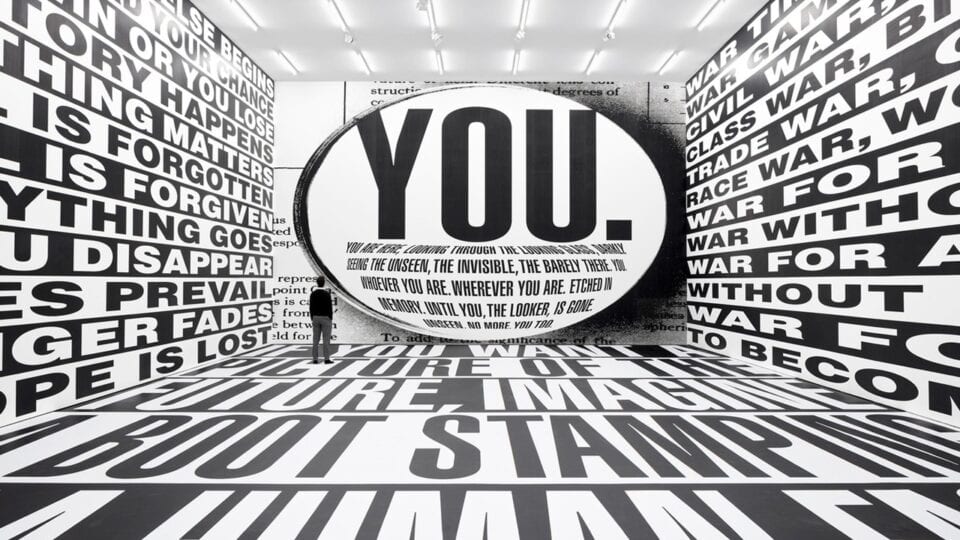For almost half a century, the US-born text artist Barbara Kruger (b. 1945) has been reworking the languages of advertising and consumer culture to produce satirical, polemical works spanning a range of media – from text-and-image billboards to video and audio. Kruger’s most iconic pieces include a poster for the 1989 Women’s March on Washington in support of abortion rights – familiar by its movement-defining slogan “Your Body Is A Battleground” – and works lampooning the brash consumerism of the 1980s such as Untitled (I Shop Therefore I am) (1987). Kruger’s work is often connected with the so-called Pictures Generation of Cindy Sherman, and taps into the movements of conceptual art, pop art, concrete poetry and more. Thinking of You. I Mean Me. I Mean You., at the Art Institute of Chicago, (currently closed) is the artist’s first solo museum exhibition in the USA since 1999. Aesthetica speaks to the show’s curator Robyn Farrell.
A: This exhibition has been described by the Chicago Institute’s director James Rondeau as an “Anti-Retrospective.” Can you offer some thoughts on that description?
RF: The exhibition addresses the breadth of Kruger’s career whilst focusing on the work from the last 20 years and does not approach her practice in a chronological manner. Instead, it confounds the conventional temporal unfolding of a career “retrospective” by looking at the philosophical and physical institutions that contain and construct our daily lives. The artist re-envisions the idea of the retrospective itself by rethinking, remaking and replaying her work in the present. The exhibition attempts to be as open-ended as the everydayness of our lives.
A: How has Kruger herself been involved in the planning of the exhibition?
RF: The exhibition was created in close collaboration with the artist. From concept to design, we have had the unique opportunity to work with Kruger on the presentation of her own history and re-conceptualising her work for our current moment. This collaboration has allowed for direct engagement with the architecture and cultural context of the institution. Kruger’s work will occupy and transcend the exhibition galleries, moving into the museum’s public spaces and beyond.
A: Kruger is famous for working within and subverting the languages of consumerism and cultural power. How have her work and role changed between the 1980s and the present day, when social media and the internet present new platforms for insidious cultural messages?
RF: For five decades, Kruger has been a consistent, critical observer of the ways in which images circulate through culture. Her early work interrogated the complex strategies of messaging from a two-dimensional perspective, and her turn to space and screen (since the 1990s) enveloped the viewer physically and psychologically within the rhetoric of images and idioms. Most recently, she has questioned the accelerated flow of images and words through contemporary culture. The urgency of Kruger’s work, as it migrates from printed surface to screen and from interior to exterior walls, from still to moving images, lies perhaps less in its material than in the ways it is continually “replayed” in the present.
A: What do you see as the place of Kruger’s work in 20th and 21st century art?
RF: Kruger’s work reflects how we “are” in our daily lives, so it holds an ongoing significance in the cultural landscape. She often says: “my work is about how we are to one another.” This situates her as the reflective mirror of the collective beliefs and doubts, kindness and cruelty, humour and empathy inherent in the human condition.
The artist was part of the first generation to grow up with television, with exposure to pop culture and first-hand experience of mass media during the late 20th century. Images and words – and their now accelerated circulation and dispersal through social media – continue to be a central focus of Kruger’s practice. Certain elements of her visual stylistics are ever present in the shortened attention spans of meme culture.
A: What is Kruger’s influence on art and culture today, and why is her work still important?
RF: In a culture obsessed with the act of looking and being looked at, Kruger poignantly and humorously questions our contemporary collision of narcissism and voyeurism. Sliding from video and photomontage to text and public installations, Kruger manoeuvres, decodes and deconstructs the messaging that mass media and social technologies perpetuate. Exposing the power structures and cultural divides of late capitalism, her images and words are as relevant in our digital age as they were 40 years ago. They have influenced more than a generation of artists; they have shaped the culture of daily lives and continue to do so.
Whilst the museum is currently closed, explore the collection virtually.
Words: Greg Thomas
Image: Installation view, Barbara Kruger, FOREVER, Sprüth Magers, Berlin 2018. Photo by Timo Ohler.





